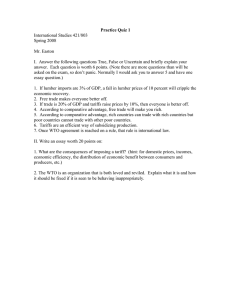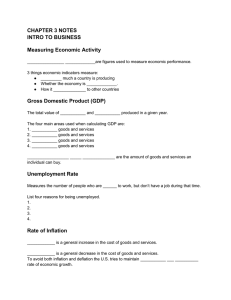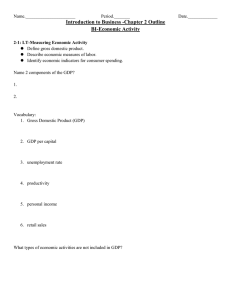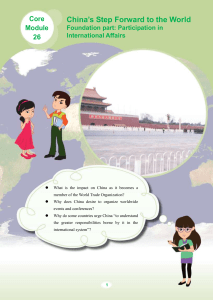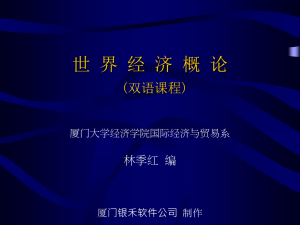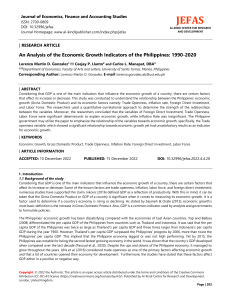Chinese Business Hung-Gay FUNG University of Missouri-St. Louis
advertisement
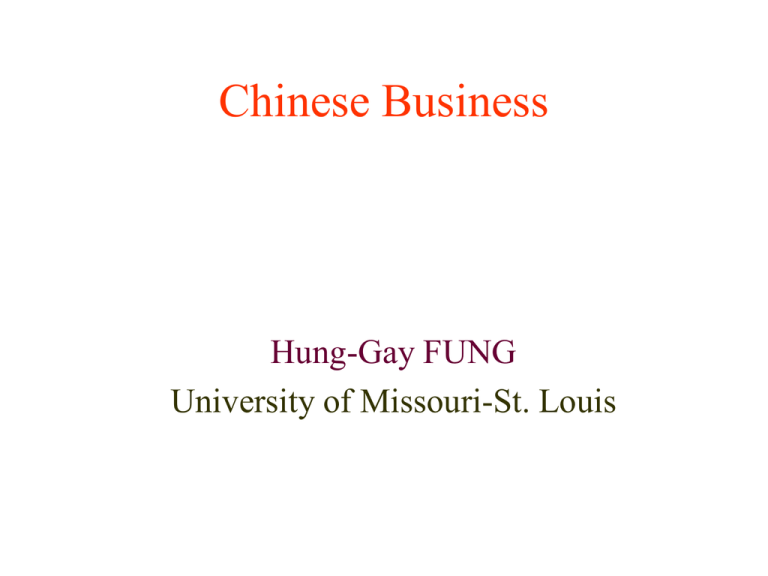
Chinese Business Hung-Gay FUNG University of Missouri-St. Louis China • The word China in the Chinese language literally means “middle kingdom.” The Chinese are thinking that China is the middle (center) of the world. • This mentality is similar to the US (in fact we are thinking that we are the universe). The map of China Beijing Beijing Shanghai Shenzhen Xi’an A small town in western China A primary school in western area Village Weaving woman Economic Data • • • • • • • • • • • • Population Population growth Urban population Life Expectancy Literacy rate GDP (US$ b) GDP growth Current account (US$b) Foreign reserves (US$b) Exports (US$b) Imports (US$b) Inflation (CPI) 1998 1.24b 1.2% 30% 71 years 81.5% 960.9 7.8% 29.3 149.2 183.8 140.2 -0.8% 2000 2001 1.26b 1,073 7.4.% 11.8 163.9 191.3 163.8 0.4% 1,196.4 7.4% 1.83 212.2 249.9 228.1 1.6% China 's Top Trade Partners in 2000 (US$ Billion) Rank 1 2 3 4 5 6 7 8 9 10 Country Japan US HK S. Korea Taiwan Germany Singapore UK Australia Russia Total trade 83.17 74.47 53.95 34.50 30.53 19.69 10.82 9.90 8.45 8.03 % Total Trade 17.54 15.70 11.37 7.27 6.44 4.15 2.28 2.09 1.78 1.69 % GDP 7.75 6.94 5.03 3.21 2.84 1.83 1.01 0.92 0.79 0.75 Source: General Administration of Customs, China Customs Statistics (2001) China and Yangtze Delta • Since 1978’s open-door policy (adopted by Deng Xiaoping) to foreign countries, China’s growth has been around 9% until the Asian currency crisis • FDI- come from Taiwan, Hong Kong, Singapore, South Korea and U.S. • Reforms --economic and political, downsizing the state-owned enterprises and government bureaucracy • Development of private and non-state owned enterprises Continued • Historical High inflation 1988 (23%) and 1994 (21.7%) • Policies to keep inflation down to 10% – reforms led to overheated economy and wage hike in 1980s – government implemented a wage and bonus tax – control inflation in 1994, using contractual monetary aggregate and fiscal deficits. continued • Success factors: – High Saving rates: 30-50% of GDP – Growth in FDI – accumulation of reserves (confidence) as a result of trade surplus – relative stable working environment (no major revolution) – hardworking of the Chinese people 4 Growing Regions in China Regions • Yangtze River Valley GDP (%) 38.5% Shanghai, Jiangsu, Zhejiang • Yellow River Valley 30.2% Beijing, Tianjin, Shandong • North-east Areas 11.3% Heilongjiang, Jilin, Liaoning • Zhujian (Pearl) River Valley Guangdong and Fujian 16.8% Regions of Development • Economic and Development Zones – along the cost – successful for the past 20 years • Development of the West and Central China – Railways and roads – oil lines Economy Structure Composition Industry Service Percentage 45 % 27 % (commerce, construction, others) Agriculture 28% Banking Sector • Central bank - People’s Bank of China • 4 big banks - control 80 % business – Bank of China, – Industrial and Commercial Bank of China, – Agricultural bank, – China’s Construction bank • Under financial reforms – bad debts Financial Markets • Two Stock Markets – – – – Shanghai Stock exchange Shenzhen Stock exchange enables state firms to raise money A-share vs. B-share • Underdeveloped bond markets Investments in China • Two types • Foreign Direct Investment (FDI) – in forms of setting up plants and factory • Portfolio investment – in stock markets (B-share investments) Total (Realized) FDI in China Year FDI ($ billion) 1984 1986 1988 1990 1992 1994 1996 1997 1998 1999 1.419 1.875 3.194 3.487 11.008 33.767 41.726 45.257 45.463 40.319 Choices of investment • • • • Representative office, Joint venture, Wholly-owned foreign enterprise Foreign investor shareholding corporation China and World Trade Organization (WTO) • Sept 17, 2001 – Accord on China’s entry into WTO is signed, clearing China’s way to WTO – The last big dispute between the US and EU over the status in the Chinese market of AIG, the US insurer is resolved – signs bilateral deal with Mexico, the last WTO member to sign for approval to admit China • Nov, 2001, formal agreement was signed WTO Effects on China • Agriculture – import tariff reduces from 21.2% to 17% over time – quota and permit for trade will be phased out – farmers may suffer most • State-owned enterprises (SOEs) - employ over 50 % population; face tense competition • Automobile industries - worst hit – tariffs cut from 25 % from current 80-100% • Textiles - shoes, toy industries may gain (export) • Financial services - may suffer
